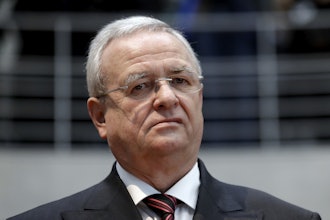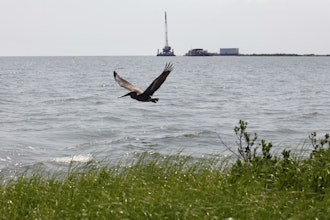DULUTH, Minn. (AP) — The sea of vehicles crowding the approach to Mesabi Nugget bespeaks the project's scale.
Somewhere between 600 and 700 contractors are on the job most days, working to launch the Iron Range's newest taconite processor.
At the peak of activity, about a month ago, upwards of 800 tradespeople were working to construct the $270 million plant that will transform taconite into pig iron.
Onsite, north of Aurora, seven massive cranes swivel and swoop, delivering steel components to scurrying workers. Skid loaders, mobile booms, delivery trucks and all manner of construction machines weave through the scene, as though performing an intricately choreographed dance.
The rising plant and the swarm of construction workers go unnoticed by most motorists whizzing past on neighboring Highway 135.
"Our project is kind of tucked back in a corner of the woods, and when people actually come out and see it, they almost always say, 'Holy smokes!'" remarked Dave Bednarz, vice president of iron resources for Steel Dynamics Inc., which is developing the plant in conjunction with Kobe Steel.
Construction of the facility began in 2007 and has not stopped despite a bruising economic downturn that has curbed taconite production throughout the region.
Staying the course has not been easy, Bednarz said.
"We never stopped work on the project or put it on hold, but for a couple of months we did sort of take our foot off the gas a little bit," he said. "As a company, we had a responsibility to look at the amount of money we were spending here."
Originally, Steel Dynamics aimed to have Mesabi Nugget begin production by the third quarter of this year, but now Bednarz predicts a November or December startup.
Revised timeline or not, the project's continued progress in the face of eroding domestic steel production and waning prices made a distinct impression on Peter Kakela, a professor at Michigan State University and a respected monitor of the taconite industry.
"I view it as a real positive sign that the work at Mesabi Nugget has been going ahead despite what the mining industry has gone through these past six months," he said. "Steel Dynamics has been the driving force, and it showed they still have a lot of confidence in the future."
Frank Bailey, a foreman for Jamar Co. and a member of Plumbers and Pipefitters Local 589 in Hibbing, credits the construction of Mesabi Nugget, combined with the revamping of Minnesota Power's Boswell Energy Center in Cohasset, for keeping him employed.
"If we didn't have this project, about 50 percent of our local would probably be unemployed," he said.
Bailey said there has been enough work even to draw distant tradespeople into northern Minnesota, as most other locals elsewhere in the state are scratching for work.
Of course, the construction jobs will disappear when the plant is completed, but Mesabi Nugget is expected to employ about 65 people on an ongoing basis. The plant is designed so it could eventually triple in size, if demand warrants. In its initial configuration, Mesabi Nugget should be able to annually produce 500,000 metric tons of pig iron.
Many of Mesabi Nugget's key future operators have been involved in designing and building the facility, including plant manager Jeff Hansen, who has been shepherding the project for more than eight years. Other members of his future operations team also have been on the job for months, if not years, and Hansen expects to reap the benefits.
"When we have a problem on a Saturday night, we'll have people involved who know every bolt and valve in the place and who will know how to fix things. That's invaluable," he said.
Mesabi Nugget will operate the world's largest rotary-hearth furnace. It's 60 meters in diameter — roughly two-thirds the length of a football field.
"This project has the potential to change the way iron mining takes place," Bednarz said. "It hasn't been an easy time to keep a project going, but that's part of what our company is about. One of our hallmarks is to be on the cutting edge of technology."
The plant will produce nuggets with an iron content of about 97 percent.
Conventional taconite plants typically produce pellets with an iron content of about 65 percent.
Steel Dynamics plans to use Mesabi Nugget's output to feed its electric arc minimills and produce flat-rolled steel. This will open a new market for Minnesota taconite mines, which have traditionally sold pellets to integrated steel producers operating large blast furnaces.
Bednarz said Mesabi Nugget will perform the same job that it now takes a pellet, sinter and coke plant plus a blast furnace to accomplish.
What's more, Steel Dynamics said Mesabi Nugget is expected to use 30 percent less energy than an integrated steelmaker would consume to make the same quantity of product. Another advantage is that the process is projected to reduce emissions of carbon dioxide and pollutants by about 40 percent, compared with traditional methods.
"I do feel it (Mesabi Nugget) is potentially a very important next step in iron mining," Kakela said, noting that the process should make for more efficient transport of iron from the Range.
Such industry innovation is nothing new, said Craig Pagel, president of the Iron Mining Association of Minnesota.
"Iron mining is often thought of as a mature industry, but the Mesabi Nugget project is yet another example of how the industry keeps reinventing itself," he said.
Mesabi Nugget plans to eventually mine its own taconite from an adjacent ore body once exploited by LTV Steel Mining Co. But the company has yet to complete work on an environmental impact study, which is a necessary precursor to the issuance of any mining permits.
That impact study could be completed and approved by the fourth quarter of 2010, said Kirk Rosenberger, a principal planner and project manager for the Minnesota Department of Natural Resources.
Until then, Mesabi Nugget will need to buy iron concentrate from other producers on the Range. In anticipation of its approaching startup, Mesabi Nugget has been buying concentrate for several months from Northshore Mining Co. in Silver Bay and from Magnetation Inc., an outfit reclaiming iron from old mine tailings near Keewatin.
Mesabi Nugget has been receiving 50 to 60 truckloads of concentrate per day, as it stockpiles material to be used once production begins. In this way, too, Bednarz said his company is supporting more jobs on the Range.






















